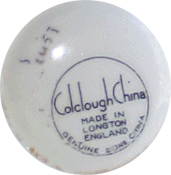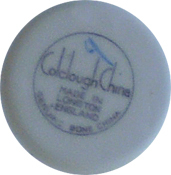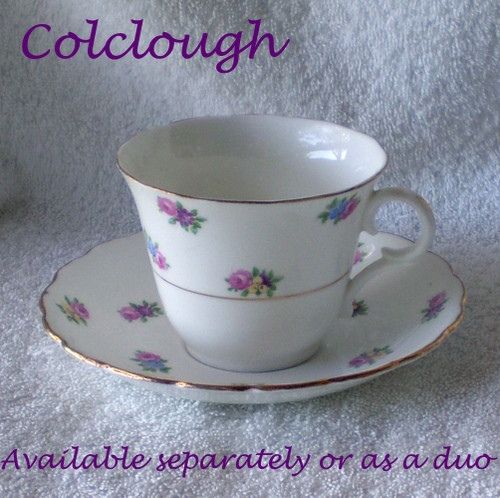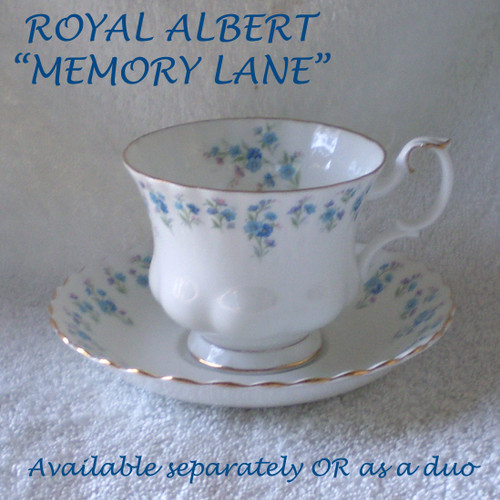HISTORY:
My wife "collects" but is changing which type of china/porcelain she wants (now pre-1900's) and she has come to realise that many of our treasured items need to "leave home" to find a new, caring home to live in.
Colclough China Ltd was formed in 1937 and operated their works at Longton, Stock-On-Trent called Vale. The use of the name began around this time so these teacups would have been one of the first designs they created.
Colclough China ceased operations in 1996 after having first been acquired by the Ridgeway Group and then subsequently, the Royal Doulton group.
It appears that this duo dates from 1939 onwards and although all British potteries were affected around this period by the Wartime Concentration Scheme, there are no letter markings on the backstamps which makes us think that these pieces left the Longton works in the late 1940's ~ early 1950's
Yet another petite design from Colclough China, very small "Boutonnieres" of English garden flowers, each being different to the others. Both pieces being finished with Gold gilding.
DLAT RATING (Darling, Look At This!) 8.5/10
COLCLOUGH CHINA LTD Teacup & Saucer Duo
(Offered separately or as a duo if both pieces still remain available)
Made In Longton, England
Price indicated is for one off EACH PIECE, however if both pieces are selected then an automatic discount does apply in the checkout
Bone China
Pattern: name is unknown - there is a number on the underside of the teacup only, this looks like 1453, hand painted using Gold which could mean this is not a pattern number but in fact the gilder's "mark"
Only the saucer has what can be clearly identified as an artist's mark, I cannot see this mark on the teacup.
Translucent, which means if held to the light you can easily see the shadow of your fingers through the china.
I have examined the decoration very closely and definitely this is hand decorated.
Gold gilding has been heavily applied around the scalloped rim of the saucer and on the teacup, the gilding has been applied to the top rim, around the outside of the teacup about halfway down the side and on the back of the handle only (not the sides)
Shapes: Both pieces are fairly "traditionally" shaped with smooth sides to the teacup and saucer.
BACKSTAMP DETAILS:
Makers mark printed on the base of the teacup

Makers mark printed on the base of the saucer

DIMENSIONS:
TEACUP: 86mm mouth x 68mm height
SAUCER: 143mm diameter
COSMETIC CONDITION:
This first section of the condition report is universal to both pieces, any difference or flaws are noted below this section
CLEAN
NO cracks
NO chips
NO crazing observed (both Wet & Dry)
NO discolouration or damage/wear was observed to the decorative work on either piece. No pieces have any "stains", in particular the inside of the teacup - clean and bright White!
NO knife cuts or scratches observed in the centre of the saucer.
NO observable wear at all to the Gold gilding on the saucer rim decoration, this gilding being quite heavily applied.
HOWEVER, the teacup gilding differs in that it is "thinner", not necessarily due to wear but just much more lightly applied. While the gilding doesn't appear to have suffered handling wear, due to the thinness of the Gold application, it does have a slightly worn appearance to the top rim and I can definitely see some very light wearing to the single strip of Gold down the back of the teacup handle.
There is one small non-discoloured fleabite to the underside of the saucer.
Overall, on both pieces, there is one or two "random" dots of decoration colour or Gold - it is as though the artist was just a little sloppy in the application of the decorative work or the gilding. I looked very closely (with a magnifying glass) at these and they are NOT useage spots or glaze failure, they are just "Woopsie!" marks.
The underside of the teacup, the foot, does have some rim glaze failure and as a result there is a slight Brownish look to the underside rim of the teacup.
Overall, this Colclough duo is in pretty good condition after 75+ years since leaving the works and being used (of course)
This duo (along with a lot of it's mates) is now sitting in a cabinet in the "departure lounge" (spare room) waiting to make a trip to it's new 'forever' home














